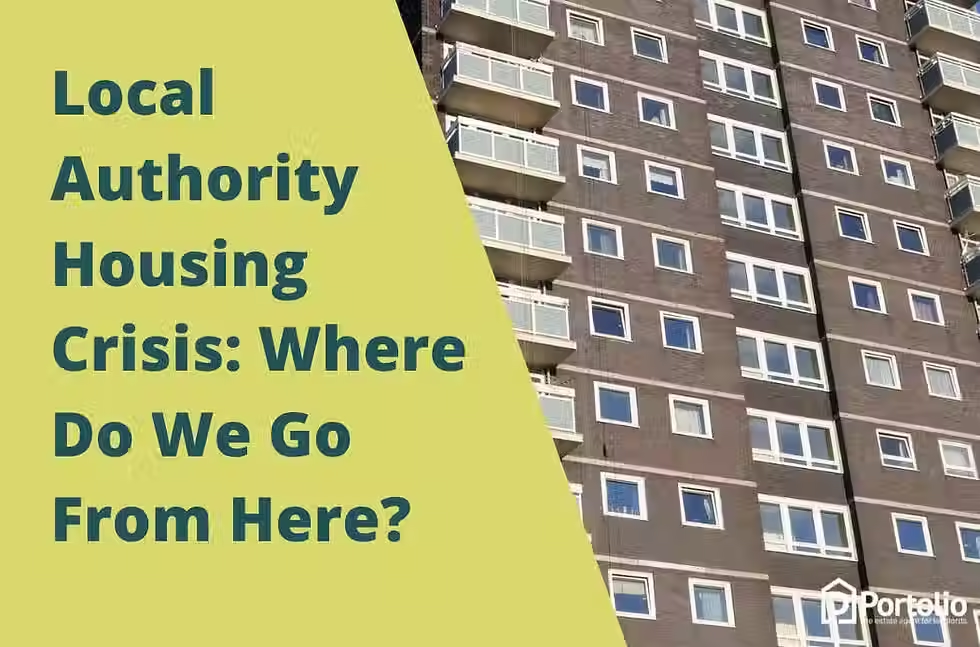How to Respond to a Local Housing Emergency: A Practical Guide for Local Authorities
- truthaboutlocalgov
- Jul 8
- 7 min read
In an age defined by volatility and rapid change, local authorities across the UK are facing mounting pressure to respond effectively to housing emergencies. These emergencies are no longer rare or isolated events, they are becoming more frequent, more complex, and more damaging. From flash floods and building fires to structural failures and public health crises, the risks are real, and the consequences can be devastating.

A housing emergency can unfold in many ways. It might be a sudden flood that forces dozens of families out of their homes overnight. It could be a fire in a high-rise block that exposes systemic safety failings. Or it might be a slow-burning crisis, such as a public health emergency that reveals the dangers of overcrowded, poorly ventilated, or insecure housing. In each case, the impact on individuals, families, and communities is profound, and the responsibility to respond falls squarely on the shoulders of local government.
Mark Baigent’s How to Respond to a Local Housing Emergency offers a timely and strategic framework for councils seeking to strengthen their capacity to respond to such emergencies. While the guidance was originally developed to help embed resilience thinking into long-term housing policy, it also provides a powerful foundation for developing practical, coordinated responses to acute housing crises.
This blog post reframes Baigent’s insights into a hands-on, action-oriented guide for local authorities, councillors, and housing professionals. It aims to support those working on the frontline of housing delivery and emergency planning, offering a clear understanding of what housing emergency resilience means, and how to build it.
Understanding Housing Emergency Resilience
At its core, housing emergency resilience is about readiness. It is the ability of a housing system, not just the buildings, but the services, institutions, and communities that support them, to withstand shocks, continue functioning under pressure, and recover quickly and fairly. It is not just about surviving a crisis, but about responding in a way that protects the most vulnerable, minimises disruption, and lays the groundwork for long-term recovery.
Baigent’s framework identifies three interdependent dimensions of resilience that are particularly relevant in the context of emergency response:
1. System Resilience
System resilience refers to the capacity of housing services, governance structures, and leadership teams to continue operating effectively during a crisis. This includes the ability to make rapid decisions, coordinate across departments, and communicate clearly with residents and partners. In an emergency, system resilience is what enables a council to mobilise temporary accommodation, deploy staff, and work with emergency services, all while maintaining essential day-to-day functions. A resilient system is one that has clear protocols, trained personnel, and strong leadership. It is also one that learns from past crises and continuously improves its preparedness.

2. Asset Resilience
Asset resilience focuses on the physical condition and adaptability of the housing stock itself. Are homes structurally sound? Are they safe from fire, flood, or overheating? Can they be quickly repaired or adapted in the event of damage? Poor-quality housing is not just a long-term policy challenge, it is a direct risk to life and health during an emergency.
Investing in asset resilience means maintaining and upgrading homes, retrofitting for energy efficiency and climate adaptation, and ensuring that emergency repairs can be carried out swiftly. It also means having contingency plans for when homes become uninhabitable, including access to temporary accommodation and rapid rehousing options.
3. Community Resilience
Community resilience is perhaps the most human dimension of the framework. It refers to the strength of social networks, the presence of trusted local institutions, and the ability of residents to support one another in times of crisis. In many emergencies, it is neighbours, community groups, and local volunteers who provide the first response, offering shelter, food, information, and emotional support. Councils can strengthen community resilience by investing in local infrastructure, supporting tenant and resident associations, and building relationships with voluntary and faith-based organisations. Engaged, informed, and connected communities are not only better able to cope with emergencies, they are also key partners in recovery and rebuilding.
These Dimensions Are Not Just Theoretical, They Are the Foundations of a Robust Emergency Response
While the concepts of system, asset, and community resilience may appear abstract at first glance, they are anything but theoretical. In practice, these dimensions form the backbone of a council’s ability to respond effectively to housing emergencies. They are the operational pillars that determine whether a local authority can act swiftly, protect vulnerable residents, and maintain public confidence during times of crisis.
System resilience ensures that the machinery of local government continues to function under pressure. It’s about having the right people, processes, and protocols in place to make decisions quickly, allocate resources efficiently, and communicate clearly with residents and partners. Without system resilience, even the best intentions can be undermined by confusion, delays, or lack of coordination.
Asset resilience is equally critical. The physical condition of housing stock can either mitigate or magnify the impact of an emergency. Homes that are well-maintained, structurally sound, and adaptable to changing conditions are far more likely to withstand environmental hazards or sudden disruptions. Conversely, poor-quality housing can turn a manageable incident into a full-blown crisis, putting lives at risk and straining emergency services.

Community resilience brings the human element into focus. In many emergencies, it is the strength of local relationships, trust in institutions, and the willingness of neighbours to support one another that determines how well a community copes. Councils that invest in community infrastructure, such as tenant associations, local charities, and neighbourhood hubs, are not just building social capital; they are creating a vital safety net that can be activated in times of need.
Together, these dimensions form a comprehensive framework for emergency preparedness. They are not optional extras or aspirational goals, they are the practical foundations upon which effective housing emergency response must be built.
Why Emergency Preparedness Matters More Than Ever
The COVID-19 pandemic was a stark reminder of how fragile housing systems can be in the face of a widespread crisis. It exposed deep-rooted vulnerabilities that had long been overlooked or underfunded. Overcrowded homes became hotspots for virus transmission. Poor ventilation and damp conditions worsened health outcomes. Insecure tenures left many residents fearful of eviction at a time when stability was most needed. Fragmented services struggled to coordinate support, leaving some communities without adequate assistance.
But COVID-19 was not an isolated event, it was a signal of what’s to come. Councils across the UK are now facing a growing and interconnected set of risks that demand urgent attention and strategic planning:
Climate-related hazards such as flooding, heatwaves, and storms are becoming more frequent and severe, threatening homes and infrastructure.
Structural failures in ageing or poorly maintained housing stock pose serious safety risks, especially in high-density urban areas.
Public health emergencies, whether infectious disease outbreaks or long-term health inequalities, continue to challenge the resilience of housing systems.
Economic shocks, including inflation, unemployment, and housing market volatility, can destabilise communities and increase demand for emergency housing support.
Social fragmentation, driven by cuts to community services and the erosion of local networks, undermines the ability of residents to support one another during crises.
In this context, emergency preparedness is no longer a peripheral concern, it is a central responsibility of local government. Councils must move beyond reactive crisis management and embrace a proactive, systems-based approach. This means investing in the capacity to anticipate risks, absorb shocks, and recover with speed and equity. It also means embedding resilience into everyday housing policy, service delivery, and community engagement.

The stakes are high. Without robust emergency preparedness, councils risk not only operational failure but also a loss of public trust. Residents expect their local authority to be ready, to protect them, support them, and lead with competence and compassion when disaster strikes. Meeting that expectation requires foresight, coordination, and a commitment to resilience at every level.
Why This Matters for Councillors and Officers
For elected members, responding effectively to housing emergencies is not just a technical responsibility, it is a matter of public trust, democratic accountability, and visible leadership. Residents rightly expect their homes to be safe, secure, and habitable. When disaster strikes, whether it’s a fire, flood, or structural failure, they look to their local councillors for reassurance, action, and advocacy.
Councillors play a vital role in setting the tone and direction of local emergency response. By championing resilience as a core principle of housing policy, they can help shift the focus from short-term fixes to long-term preparedness. This means advocating for investment in housing quality, supporting cross-sector collaboration, and ensuring that emergency planning is inclusive and equitable.
Moreover, resilience aligns with many of the broader political priorities that councillors are already working to advance. It supports climate action by promoting sustainable, energy-efficient homes. It contributes to health equity by addressing the root causes of poor housing conditions. And it strengthens community empowerment by investing in local networks and infrastructure that enable residents to support one another in times of need.
For housing officers, resilience offers a unifying framework that brings together strategy, service delivery, and emergency planning. It encourages a shift in mindset, from reactive firefighting to proactive future-proofing. Rather than waiting for a crisis to occur, officers are empowered to anticipate risks, design flexible services, and build the capacity to respond effectively when emergencies arise.
Resilience thinking also provides a compelling narrative for innovation and investment. It helps officers make the case for funding repairs, retrofitting homes, and strengthening community partnerships. It offers a language that resonates with senior leaders, funders, and external partners, one that connects housing to wider goals such as public health, climate adaptation, and social inclusion.
In short, resilience is not an add-on to the work of councillors and officers, it is central to their mission. It enables them to lead with confidence, act with compassion, and deliver services that are robust, responsive, and rooted in the needs of their communities.

Conclusion: From Crisis to Capacity
Local authorities are uniquely positioned to lead the way in housing emergency response. They are not only landlords and service providers, they are also place-shapers, community convenors, and system stewards. This multifaceted role gives councils both the responsibility and the opportunity to build housing systems that are resilient, inclusive, and prepared for the challenges ahead.
By embedding resilience into housing policy and practice, councils can:
Prevent crises by identifying and addressing vulnerabilities before they escalate
Reduce long-term costs by investing in prevention rather than relying on emergency interventions
Protect health and wellbeing by ensuring that homes are safe, secure, and fit for purpose
Strengthen communities by supporting local networks, institutions, and mutual aid
Adapt to climate risks through sustainable design, retrofitting, and energy efficiency
Build public trust by demonstrating competence, care, and leadership in times of uncertainty

Mark Baigent’s How to Respond to a Local Housing Emergency makes it clear: resilience is not a buzzword or a policy trend, it is a practical, strategic necessity. It is the foundation for a housing system that can withstand shocks, recover quickly, and serve all residents, especially the most vulnerable, with dignity and fairness.
As the frequency and complexity of housing emergencies continue to grow, councils must be ready to respond, not just with urgency, but with clarity, compassion, and confidence. With the right tools, partnerships, and political will, local authorities can turn crisis into capacity, and uncertainty into opportunity.



